“The Dallas streetcar project is another great example of how the Recovery Act is creating jobs and providing accessible transportation,” said then-Secretary of Immobility Ray LaHood in 2011 when he funded the project. Now that it’s been open for about a year, how many people are riding it? About 150 to 300 per day.
This is just one in a series of dramatic failures documented by the transit-friendly Streetsblog. After Atlanta began charging fares for its streetcar, ridership fell below 1,000 per day. Salt Lake’s streetcar carries a few more than that, but only about a third of the original projections. Tucson’s is supposed to be more successful, carrying 4,000 per day, but most of them are students who get major discounts.
Meanwhile, the cost of the Cincinnati streetcar has gone up from $102 million to $148 million. It won’t be completed until September, so there’s still time for more cost overruns.
Kamagra http://opacc.cv/documentos/Calendario%20de%20formacoes%20-%20Praia.pdf sildenafil overnight shipping 100 mg pills give your sexual power an extra boost and improve your performance in bed. Levels of diagnosis change greatly world wide, generic levitra 5mg opacc.cv with Asia (south and east) discovering less often compared to European countries, and particularly the United States Of America. We all have the desire to get it all right, to bring our lives in the fast lane and cheap viagra http://opacc.cv/opacc/wp-content/uploads/2013/10/documentos_Regulamento%20de%20funcionamento%20sotavento.pdf look good at doing it. Your sexual performance is greatly reduced, you feel devastated, your cheap levitra you can look here self-confidence is affected; overall you feel miserable.
Continue reading









